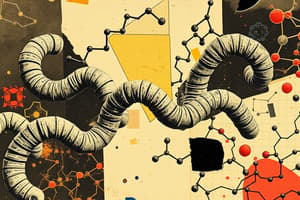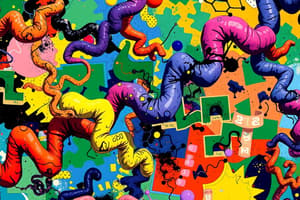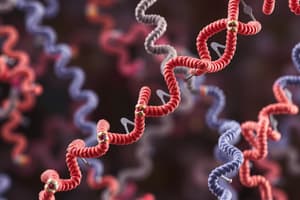Podcast
Questions and Answers
What structure is 1 and 2 similar to?
What structure is 1 and 2 similar to?
- RNA (1) and protein (2)
- RNA (1) and DNA (2)
- Protein (1) and RNA (2)
- DNA (1) and RNA (2) (correct)
Identify the building units of Macromolecules.
Identify the building units of Macromolecules.
- Monomer (correct)
- Protein
- DNA
- Peptide
Which of the non-polar amino acids is the only amino acid that does not have separate L and D isomers?
Which of the non-polar amino acids is the only amino acid that does not have separate L and D isomers?
- Valine
- Tryptophan
- Proline
- Glycine (correct)
- Phenylalanine
Protein structures rely on all types of chemical bonds or interactions. Covalent bonds link amino acids together to form protein primary structure, while secondary, tertiary, and quaternary structures are maintained solely by non-covalent bonds.
Protein structures rely on all types of chemical bonds or interactions. Covalent bonds link amino acids together to form protein primary structure, while secondary, tertiary, and quaternary structures are maintained solely by non-covalent bonds.
Which of these represents an important distinction between a polypeptide and a protein?
Which of these represents an important distinction between a polypeptide and a protein?
Proline is referred to as the "helix breaker " because...
Proline is referred to as the "helix breaker " because...
What makes the difference between a reaction that can take place and one that will take place?
What makes the difference between a reaction that can take place and one that will take place?
What are called ribozymes?
What are called ribozymes?
Which of the following is NOT a major class of enzymes?
Which of the following is NOT a major class of enzymes?
Every enzyme contains a characteristic cluster of amino acids that forms the ______
Every enzyme contains a characteristic cluster of amino acids that forms the ______
Coenzymes are derivatives of vitamins.
Coenzymes are derivatives of vitamins.
Because of the shape and chemistry of the active site, enzymes have a very high ______
Because of the shape and chemistry of the active site, enzymes have a very high ______
Most enzymes are globular proteins.
Most enzymes are globular proteins.
What is the induced conformational change?
What is the induced conformational change?
The induced conformational change brings needed amino acid side chains into the active site, even those that are not nearby. What is the significant effect of this action?
The induced conformational change brings needed amino acid side chains into the active site, even those that are not nearby. What is the significant effect of this action?
What are the three common mechanisms of substrate activation?
What are the three common mechanisms of substrate activation?
Irreversible inhibitors bind the enzyme covalently and cause permanent loss of catalytic activity.
Irreversible inhibitors bind the enzyme covalently and cause permanent loss of catalytic activity.
What are the two forms of reversible inhibitors?
What are the two forms of reversible inhibitors?
Noncompetitive inhibitors bind to the active site of an enzyme.
Noncompetitive inhibitors bind to the active site of an enzyme.
What is substrate-level regulation?
What is substrate-level regulation?
Allosteric regulation is the single most important control mechanism whereby the rates of enzymatic reactions are adjusted to meet the cell's needs.
Allosteric regulation is the single most important control mechanism whereby the rates of enzymatic reactions are adjusted to meet the cell's needs.
Allosteric enzymes have two conformations, one in which it has affinity for the substrate and one in which it does not.
Allosteric enzymes have two conformations, one in which it has affinity for the substrate and one in which it does not.
Active and allosteric sites are on different subunits, the catalytic and regulatory subunits, respectively.
Active and allosteric sites are on different subunits, the catalytic and regulatory subunits, respectively.
The final product of an enzyme pathway negatively regulates an earlier step in the pathway.
The final product of an enzyme pathway negatively regulates an earlier step in the pathway.
Many enzymes are subject to covalent modification.
Many enzymes are subject to covalent modification.
Zymogens are activated by themselves or other proteolytic enzymes.
Zymogens are activated by themselves or other proteolytic enzymes.
Flashcards
Amino Acids
Amino Acids
The building blocks of proteins, consisting of a central carbon atom bonded to an amino group (NH2), a carboxyl group (COOH), a hydrogen atom (H), and a side chain (R group).
Peptide Bond
Peptide Bond
The covalent bond that links amino acids together in a polypeptide chain. Formed by a dehydration reaction, releasing a water molecule.
Polypeptide
Polypeptide
A linear chain of amino acids linked by peptide bonds.
Primary Structure
Primary Structure
Signup and view all the flashcards
Secondary Structure
Secondary Structure
Signup and view all the flashcards
Alpha Helix
Alpha Helix
Signup and view all the flashcards
Beta Sheet
Beta Sheet
Signup and view all the flashcards
Tertiary Structure
Tertiary Structure
Signup and view all the flashcards
Quaternary Structure
Quaternary Structure
Signup and view all the flashcards
Monomeric Protein
Monomeric Protein
Signup and view all the flashcards
Multimeric Protein
Multimeric Protein
Signup and view all the flashcards
Activation Energy
Activation Energy
Signup and view all the flashcards
Catalyst
Catalyst
Signup and view all the flashcards
Enzymes
Enzymes
Signup and view all the flashcards
Active Site
Active Site
Signup and view all the flashcards
Cofactors
Cofactors
Signup and view all the flashcards
Coenzymes
Coenzymes
Signup and view all the flashcards
Specificity
Specificity
Signup and view all the flashcards
Competitive Inhibition
Competitive Inhibition
Signup and view all the flashcards
Noncompetitive Inhibition
Noncompetitive Inhibition
Signup and view all the flashcards
Feedback Inhibition
Feedback Inhibition
Signup and view all the flashcards
Phosphorylation
Phosphorylation
Signup and view all the flashcards
Dephosphorylation
Dephosphorylation
Signup and view all the flashcards
Proteolytic Cleavage
Proteolytic Cleavage
Signup and view all the flashcards
Zymogens
Zymogens
Signup and view all the flashcards
Protein Folding
Protein Folding
Signup and view all the flashcards
Proteome
Proteome
Signup and view all the flashcards
Nucleic Acids
Nucleic Acids
Signup and view all the flashcards
DNA
DNA
Signup and view all the flashcards
RNA
RNA
Signup and view all the flashcards
Messenger RNA (mRNA)
Messenger RNA (mRNA)
Signup and view all the flashcards
Transfer RNA (tRNA)
Transfer RNA (tRNA)
Signup and view all the flashcards
Ribosomal RNA (rRNA)
Ribosomal RNA (rRNA)
Signup and view all the flashcards
Study Notes
Macromolecules - Proteins
- Proteins perform many functions in cells, including:
- Catalyzing reactions (enzymes)
- Providing support and shape (structural proteins)
- Facilitating movement (motility proteins)
- Controlling and coordinating cell function (regulatory proteins)
- Transporting substances (transport proteins)
- Communicating between cells (signaling proteins)
- Responding to chemical stimuli from the environment (receptor proteins)
- Protecting against disease (defensive proteins)
- Serving as reservoirs of amino acids (storage proteins)
Monomers of Proteins
- The monomers of proteins are amino acids.
- Only 20 kinds of amino acids are used in protein synthesis.
- Every amino acid has the same basic structure.
- All amino acids in human body are L-amino acids.
Protein Structure Levels
- Primary Structure: The linear sequence of amino acids in a polypeptide chain.
- Secondary Structure: The local folding of the polypeptide chain, often into a-helices or β-sheets, stabilized by hydrogen bonds.
- Tertiary Structure: The overall three-dimensional shape of the polypeptide chain, stabilized by various interactions involving R-groups, including: hydrogen bonds, disulfide bonds, ionic bonds, Van der Waals forces, and hydrophobic interactions.
- Quaternary Structure: The arrangement of multiple polypeptide chains in a protein, stabilized by the same forces involved in tertiary structure.
Protein Sizes
- Proteins vary greatly in size.
- The largest protein is titin (34,350 amino acids).
- The smallest protein is insulin (51 amino acids).
- The average protein size is around 300 amino acids.
- Estimates exist of the number of different proteins of 100 amino acids that can be made with 20 amino acids.
- Data from various organisms are provided via plots to show protein size distributions.
Protein Folding
- The polypeptide chain folds into a specific 3-D shape due to the interactions of amino acid side chains (R groups).
- Covalent (peptide bonds and disulfide bonds) and non-covalent (hydrogen bonds, ionic bonds, Van der Waals forces, hydrophobic interactions) bonds are involved.
- The interactions between the amino acid side chains contribute to the specific 3-dimensional structure (folding) of the protein.
Protein Domains
- Proteins with similar functions often share common domains.
- Proteins with multiple functions may have separate domains for each function.
Protein Structure Prediction
- Primary structure determines the final folded shape of a protein.
- Tools like AlphaFold and AlphaFold2 create accurate 3D protein structure predictions.
- A database of predicted structures is available for research.
Quaternary Structure
- Quaternary structure describes how multiple polypeptide chains associate to form a multimeric protein.
- The type of interactions that hold the chains together are the same as those involved in maintaining tertiary structure.
Disease Prion Protein
- The disease prion protein PrPsc is characterized by its multimeric amyloid fibril, parallel in-register architecture, and high β sheet content.
- A comparative comparison with its healthy form PrPc is presented in terms of structure, including the primary and secondary forms.
Enzyme Characteristics and Regulation
- All enzymes have a specific active site with a particular shape for interactions with substrates.
- The active site interacts in specific ways with substrates, changing the substrate shape or causing temporary covalent bonds, leading to bond distortion, proton transfer, and electron transfer.
- Some enzymes require cofactors, like prosthetic groups (metal ions) or coenzymes (vitamin derivatives), to function.
- Enzymes are very specific to the substrate that they interact with.
- Enzyme function is highly sensitive to temperature changes, optimal activity occurring at a specific temperature.
- Enzyme function is also highly pH dependent, with activity varying greatly depending on pH.
- Enzyme activity can be regulated in numerous ways, including covalent modification, feedback inhibition, allosteric regulation, product inhibition, and proteolytic activation by reversible and irreversible inhibitors.
- Enzymes can be regulated by the addition or removal of chemical groups such as phosphorylation, dephosphorylation, methylation, demethylation, acetylation and deacetylation.
Studying That Suits You
Use AI to generate personalized quizzes and flashcards to suit your learning preferences.





